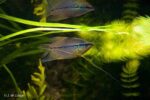Trichopodus leerii – Pearl Gourami
Trichopodus leerii was officially described by Bleeker in 1852. The genus name can be broken down into two parts. “Trichos” means “hair” or “ray”. “Gaster” means “belly”. This is a reference to the pectoral fins, each of which consists of one long, hair-thin thread. They use these to scan objects.
Their common names are Pearl Gourami or Diamant Gourami. Their common name is easy to explain. This species has small dots on the flank. Like it’s studded with all kinds of pearls or diamonds.
Synonyms: Trichogaster leerii, Trichopus leerii.
Description
The Pearl Gourami can reach a length of about 12 centimeters. From the nose to the caudal peduncle runs a black row of dots that form a black stripe. You can see small white dots all over the body and over the fins, these are the pearls or diamonds that give this species its name. Like many Gouramis, their pectoral fins consist of two wires with which they can sense the environment.
The difference between the male and female can be seen in a few differences in Trichopodus leerii. The male has an orange/red throat and beginning of the abdomen, a longer dorsal and anal fin, and many “fringes” on his pelvic fin. The female does not have these fringes. The female is usually smaller and thicker.
In character, these are very peace-loving fish. They are ideal for a community aquarium. It is better not to combine them with overly busy or aggressive varieties.
Because they are relatively easy to grow, the stock in the shops mainly consists of captive bred specimens. For this species it is not immediately necessary to catch specimens from the wild.
Biotope
The Pearl Gourami comes from Asia. They occur in Indonesia on Borneo and Sumatra, Malaysia and Thailand.
They usually inhabit the swampy areas along the coast.
Diet
The Pearl Gourami is an omnivore, both small live food and frozen food, such as mosquito larvae, cyclops, artemia, food tablets and granulate, also vegetbale food and dry food, so make sure you have enough variety.
The Aquarium
An aquarium for the Pearl Gourami should be 120 centimeters in length or more. Set up the aquarium with many plants. Also provide some floating plants under which they can shelter.
Gouramis do not like current in the water. A filter with a wide outlet where the flow of water disappears fairly quickly is appreciated. If they want to build a bubble nest, it is on the surface of the water. If the current is too strong, the bubbles will not stick together.
Water parameters
Temperature: 24-28 degrees Celsius. PH: 5.5-7.5 GH: 2-16 In nature, fish have to deal with fluctuating temperatures. Keeping fish at the minimum or maximum temperature for a long time is not always desirable and can shorten the average lifespan of the fish.
Breeding aquarium and conditioning
It is best to use a breeding aquarium for the breeding of the Diamond Gourami. Provide a water level of around 12 centimeters. Decorate the aquarium with lots of floating plants. Preferably use a sponge filter or hamburger mat filter so the fry are not sucked up by the filter later. The current should not be too strong because with a strong current the bubble nest will fall apart.
The water may have a temperature of about 26 to 28 degrees Celsius.
Now place a male and female in the breeding aquarium. Condition them by feeding them well with high quality live food.
The spawn
When the female becomes somewhat fatter and is full of eggs, the Trichopodus leerii male builds a bubble nest between the floating plants. This bubble nest is quite large and can be up to 25 centimetres in diameter.
The man now approaches the woman and shows her how beautiful he is. When she is ready to lay the eggs, they touch each other with their sensing threads.
They hug each other under the bubble nest. During this embrace, the female releases a number of eggs. The eggs are fertilized directly by the male. The eggs float and are hung in the bubble nest by the male.
The embracing and releasing of the eggs are repeated over and over until all the eggs have been released. These are about 200 to 300 eggs. As soon as the female stops releasing eggs, she is chased away by the male.
Now remove the Pearl Gourami female and place her back in the normal aquarium. The male protects the nest from other fish, including the female. He can be quite aggressive in doing so.
Raising the fry
The male takes care of the eggs. These hatch after about 20 to 30 hours. They will then remain in the bubble nest. The male continues to maintain the bubble nest until the fry can swim free, about four to five days later. Now also remove the male and place him back in the normal aquarium.
The young Pearl Gouramis are very small. The first week you can feed them with infusoria (or Liquifry). You grow very slowly, only after a week, you can switch to slightly larger food such as microworms and freshly hatched brine shrimp.
Make sure you don’t feed too much. The tiny young Pearl Gouramis cannot withstand fluctuations in water quality, water values and temperature. Therefore, always change small amounts of water at a time. Only after about three months, they are a bit stronger and they are more resistant to fluctuations in the water values.
Conclusion
The Pearl Gourami is really an eye-catcher in a community aquarium. Their colours and shape are sure to attract attention. With the right equipment and little current, they inhabit the upper water layer and usually leave other fish alone. Be careful not to combine them with too busy or aggressive varieties.
See also the breeding report Breeding the Pearl Gourami
Video
Authors
Coby
John de Lange
Copyright images
John de Lange















Reviews
There are no reviews yet.